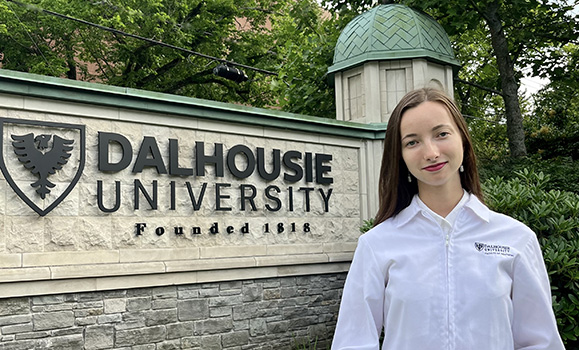From Bohdana Bila's perspective, international research experience is more than just an add-on to her academic experience. For the Ukrainian student, it's essential.
“We need to understand that people in Ukraine, especially those who study there, need help from supervisors and teachers all around the world to be able to satisfy their dreams in a practical way,” says Bohdana.
Bohdana is a summer research intern working with Dr. Richard Price and his team at Dalhousie's Faculty of Dentistry to research differences in dental curing lights. Dr. Price is a leading researcher on dental curing lights and a professor in the Department of Dental Clinical Sciences and School of Biomedical Engineering.
Under the curing lights
Following her graduation from dental school in Ukraine, Bohdana began her master’s degree and decided to seek research opportunities abroad.
Her friend, Yaryna Tylchak, informed Bohdana that Dr. Price was looking for a summer intern. After Bohdana expressed her interest in the opportunity, Dr. Price offered Bohdana the internship and successfully applied for funding through Mitacs Globalink and Research Nova Scotia’s Ukrainian Emergency Research Support Program.

“I’m very appreciative of the support from Dr. Price, the people in the lab, Research Nova Scotia, and Mitacs because this is a great opportunity to grow,” explains Bohdana. “For me, it’s really important to make not only an impact on science, but also impact to the practical work for the people who are going to use it.”
Dentists use curing lights every day in their offices to cure adhesives, harden white fillings, cement crowns, and bond brackets onto teeth. An estimated 800 million fillings that required the use of a curing light were placed in 2014. These fillings need a good curing light to prevent inadequate polymerization and premature failure.
This internship opportunity has allowed Bohdana to see and test the wide range of curing lights available in Dr. Price’s laboratory and to learn how to effectively plan and implement a research project. Bohdana has seen first-hand that not all curing lights are the same and they produce different results. Surprisingly, most dentists are unaware of the tremendous differences between curing lights, and how this can have a significant impact on how the filling material, cements, and resins are cured in the mouth.
The results from a survey Bohdana conducted in Ukraine showed that most dentists believe all curing lights are equal and often make purchasing decisions based on useability, brand and marketing, cost, and the warranty period. Only two to three per cent of respondents said they look at the irradiance or the power, the emission spectrum (colour of light emitted), and beam profile (uniformity) of the curing lights. Dr. Price reports that this result doesn’t surprise him because every study published has shown that most dentists know very little about curing lights.
Making opportunities possible
Research Nova Scotia’s Ukrainian Emergency Research Support Program has supported Bohdana’s three month stay in Nova Scotia and has helped fund the equipment she needs to conduct her research.
“We implemented the Ukrainian Emergency Research Support Program to support Ukrainian researchers’ work while they are in Nova Scotia. This project not only supports a Ukrainian researcher; it is producing important research results,” says Stefan Leslie, CEO of Research Nova Scotia. “Bohdana’s research has the potential to inform better dental practices and improve patient outcomes in Nova Scotia, Ukraine, and beyond.”

Working with Dr. Price, she has learned how to measure the output from lights, analyze their differences, and test outcomes. Dr. Price and Bohdana plan on submitting at least one article for publication based on her work in Canada. On her way back to Ukraine, Dr. Price has arranged for her to visit a major dental company, Ultradent, in the United States where she will present her research results. She will then return home to Ukraine to complete her master’s program and she hopes to submit another paper.
Bohdana is looking forward to bringing her research findings back to Ukraine and to share her work at student dental conferences because she already has a lot of experience in organizing such events.
“These three months here in Canada, at Dalhousie with Dr. Price, is a great opportunity to grow professionally and to bring greater investments to the industry when I go back to Ukraine,” explains Bohdana. “In Ukraine, it doesn’t matter if you are a scientist, a student, or a worker; everything you do, every day, you do for a better future.”

